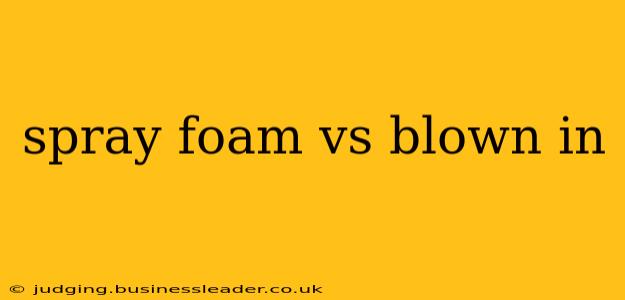Choosing the right insulation for your home is a crucial decision impacting energy efficiency, comfort, and long-term costs. Two popular options frequently top the list: spray foam insulation and blown-in insulation. This comprehensive guide will delve into the key differences between spray foam and blown-in insulation, helping you make an informed choice for your specific needs.
What is Spray Foam Insulation?
Spray foam insulation is a two-part liquid mixture that expands upon application, filling gaps and cracks to create an air-tight seal. It's available in two main types: open-cell and closed-cell. Open-cell spray foam is less expensive and offers good insulation value, but it's more permeable to air. Closed-cell spray foam is denser, more expensive, and provides superior insulation and air sealing, acting as a formidable barrier against moisture.
What is Blown-In Insulation?
Blown-in insulation, typically made of cellulose, fiberglass, or mineral wool, is installed using specialized machinery that blows the material into walls, attics, and other cavities. It's a more established and widely-used method, offering good insulation properties and cost-effectiveness, particularly for larger areas. However, it's less effective at air sealing than spray foam.
Spray Foam vs. Blown-In: Key Differences
Here's a head-to-head comparison of the two insulation types across several key factors:
R-Value (Insulation Effectiveness)
- Spray Foam: Closed-cell spray foam boasts a significantly higher R-value per inch than open-cell spray foam or blown-in insulation, meaning it provides superior thermal resistance. Open-cell spray foam falls somewhere in between.
- Blown-In: The R-value of blown-in insulation varies depending on the material and installation thickness. Fiberglass generally has a lower R-value than cellulose or mineral wool.
Air Sealing
- Spray Foam: Both open-cell and, especially, closed-cell spray foam excel at air sealing, creating a continuous, airtight barrier that minimizes drafts and energy loss.
- Blown-In: Blown-in insulation offers decent air sealing, but it's not as effective as spray foam, particularly in preventing air infiltration through cracks and gaps.
Moisture Resistance
- Spray Foam: Closed-cell spray foam provides excellent moisture resistance, acting as a vapor barrier and preventing water damage. Open-cell spray foam offers some moisture resistance, but not to the same extent.
- Blown-In: Blown-in insulation's moisture resistance depends on the material and proper installation. Moisture can penetrate cellulose insulation if not properly protected.
Cost
- Spray Foam: Spray foam insulation is generally more expensive than blown-in insulation, especially closed-cell spray foam. The higher upfront cost is often offset by long-term energy savings.
- Blown-In: Blown-in insulation is typically less expensive to install, making it a budget-friendly option.
Installation Time
- Spray Foam: Spray foam installation is often quicker for smaller areas, but it can be more time-consuming for large projects. The expansion process and need for precise application can add to installation time.
- Blown-In: Blown-in insulation installation can be faster for larger projects as the material is quickly dispersed.
Durability and Lifespan
- Spray Foam: Spray foam insulation has a very long lifespan, lasting for decades with minimal degradation.
- Blown-In: The lifespan of blown-in insulation varies depending on the material and installation quality. Proper installation can extend its lifespan considerably.
Which Insulation is Right for You?
The best insulation choice depends on your specific needs, budget, and home's characteristics. Consider the following:
Climate Considerations:
Colder climates often benefit more from the superior insulation and air sealing of closed-cell spray foam, reducing heating costs significantly. Warmer, humid climates might favor closed-cell spray foam for its moisture resistance.
Budget:
If budget is a primary concern, blown-in insulation offers a more cost-effective solution. However, remember to factor in the potential for future energy cost savings.
Home Structure and Accessibility:
Spray foam is ideal for hard-to-reach areas and irregular cavities. Blown-in insulation works well for larger, more accessible spaces.
Frequently Asked Questions
Is spray foam insulation environmentally friendly?
Some spray foam formulations contain chemicals that may raise environmental concerns, but there are also eco-friendly options available made with bio-based ingredients. Check the product's environmental credentials before purchasing.
Can I install blown-in insulation myself?
While it's tempting to DIY blown-in insulation, proper installation requires specialized equipment and expertise. Improper installation can compromise its effectiveness and create problems.
What are the potential drawbacks of spray foam insulation?
Spray foam can be more expensive than blown-in, and some formulations may contain volatile organic compounds (VOCs). Proper ventilation is crucial during and after installation.
How long does it take to install spray foam insulation?
Installation time varies based on the size of the area and the installer's experience. It is generally faster than blown-in for smaller projects.
Which insulation is better for soundproofing?
Both spray foam and blown-in insulation offer some sound dampening properties, but spray foam, particularly closed-cell, generally provides better soundproofing due to its denser structure and airtight seal.
By carefully considering these factors and comparing the pros and cons of spray foam and blown-in insulation, you can make an informed decision that best suits your home's needs and your budget. Remember to consult with a qualified insulation professional to discuss your options and get a personalized recommendation.
